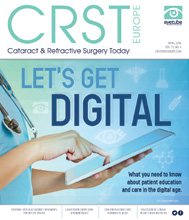LET'S GET DIGITAL

approaches to patient education and marketing can depend on age
By Arthur B. Cummings, MB ChB, FCS (SA), MMed (Ophth), FRCS (Edin); Soosan Jacobs, MS, FRCS, DNB; Simonetta Morselli, MD;
Antonio Tosao, MD; and Karl G. Stonecipher, MD
Communication . . . still carries the classical meaning of an exchange between two people. For doctors, successful communication with patients requires several things. First, information must be simplified so that the patient can be aware of all of the options available to him or her. Second, the fears and apprehensions of patients and their companions must be allayed. Third, patients must be encouraged to learn more about their diseases and treatment options. In the office setting, these things are accomplished mostly in a verbal fashion, and, in the online world, through digital means.
REDUCING DISSATISFACTION

Monitoring feedback can help improve patients’
experiences
By Joshua W. Kim, MD
When I think about dissatisfied patients, the famous comment of the poet John Lydgate comes to mind: “You can please some of the people all of the time, you can please all of the people some of the time, but you can’t please all of the people all of the time.” These words may help physicians cope when a dissatisfied patient comes along, but with today’s social media, one unhappy patient can significantly affect an eye care practice.
Every doctor has encountered a dissatisfied patient in the office. Maybe his or her appointment started a few minutes late, or he or she did not realize how many visits would be required after surgery. Alleviating dissatisfaction begins with determining its source. Once the cause of the unhappiness is known, physicians and staff can pull together to resolve the problem.
FUNDAMENTALS IN FIVE


LIMBAL STEM CELL DEFICIENCY AND ITS MANAGEMENT
By Evripidis Sykakis, MD, MSc, FEBO,
and Damian B. Lake, MBBS, FRCOphth
Limbal stem cells can be partially or totally depleted, resulting in varying degrees of stem cell deficiency and resulting abnormalities on the ocular surface. These abnormalities, such as corneal neovascularization, scarring, and persistent epithelial defects, can cause symptoms of reduced vision or blindness, chronic ocular irritation, and discomfort


